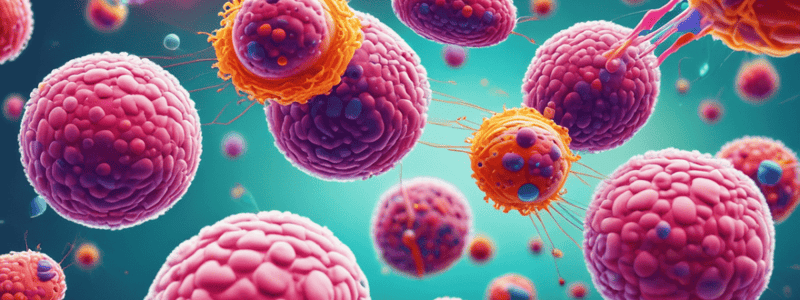Podcast
Questions and Answers
What is the main function of Memory B cells?
What is the main function of Memory B cells?
To recognize the same pathogen and produce specific antibodies against it.
Explain the process of affinity maturation in Memory B cells.
Explain the process of affinity maturation in Memory B cells.
Affinity maturation leads to increased specificity and affinity of antibodies for the pathogen.
What is the timeframe difference in antibody production between the first pathogen encounter and a memory response?
What is the timeframe difference in antibody production between the first pathogen encounter and a memory response?
2 weeks for first encounter, 2-4 days for a memory response.
Describe natural immunity and how it is acquired.
Describe natural immunity and how it is acquired.
Differentiate between active immunity and passive immunity.
Differentiate between active immunity and passive immunity.
Study Notes
Here are the study notes for the text:
Functions of Organs and Cells of the Immune System
- The immune system is the body's defense mechanism against pathogens and foreign substances.
- The immune system consists of:
- White blood cells (leukocytes)
- Spleen
- Bone marrow
- Lymphatic system
- Thymus
- Tonsils, adenoids, and appendix
- Primary immune organs:
- Bone marrow (produces hematopoietic stem cells)
- Thymus (produces mature T cells)
- Secondary immune organs:
- Lymph nodes (initiate and coordinate immune responses)
- Spleen (traps bloodborne antigens)
- Tonsils (respond to antigens that enter through the mouth and throat)
Cells of the Immune System
- Types of immune cells:
- Granulocytes (neutrophils, eosinophils, basophils)
- Monocytes (macrophages, dendritic cells, mast cells)
- Lymphocytes (B cells, T cells, natural killer cells)
- Functions of immune cells:
- Phagocytose (consume) invading pathogens
- Mark pathogens for destruction
- Produce antibodies to mark pathogens for destruction
- Kill infected cells directly
Innate Immunity
- Definition: immediate defense against pathogens
- Components of innate immunity:
- Epithelial barriers (skin, mucous membranes)
- Phagocytic cells (neutrophils, macrophages)
- Dendritic cells
- Natural killer cells
- Complement system
- Pattern recognition receptors:
- Recognize pathogen-associated molecular patterns (PAMPs)
- Trigger innate immune responses
Adaptive Immunity
- Definition: specific, long-lasting immunity
- Components of adaptive immunity:
- Humoral immunity (antibodies)
- Cell-mediated immunity (T cells)
- Types of adaptive immunity:
- Active immunity (develops after infection or vaccination)
- Passive immunity (transfers antibodies from another individual)
Antigens and Antibodies
- Definition of antigens:
- Substances that stimulate the immune system to produce antibodies
- Can be proteins, lipids, carbohydrates, or nucleic acids
- Definition of antibodies:
- Immunoglobulins produced by B cells
- Recognize and bind to specific epitopes on antigens
- Structure of antibodies:
- Y-shaped molecule with variable and constant regions
- Heavy chains and light chains held together by disulfide bonds
Vaccines
- Definition: biological preparations that stimulate the immune system to develop immunity to a specific disease
- Types of vaccines:
- Inactivated vaccines (killed pathogens)
- Live-attenuated vaccines (weakened pathogens)
- Messenger RNA (mRNA) vaccines
- Subunit, recombinant, polysaccharide, and conjugate vaccines
- Toxoid vaccines
- Viral vector vaccines
Mechanisms of Immune Memory
- Definition: ability of the immune system to recognize and respond to previously encountered pathogens
- Components of immune memory:
- Memory T cells
- Memory B cells
- Functions of immune memory:
- Rapid and enhanced response to re-exposure to antigens
- Protection against future infections
Natural and Artificially Acquired Immunity
- Natural immunity: acquired through exposure to pathogens in the environment
- Artificially acquired immunity: obtained through vaccination
- Types of artificially acquired immunity:
- Active immunity (develops after vaccination or infection)
- Passive immunity (transfers antibodies from another individual)
Studying That Suits You
Use AI to generate personalized quizzes and flashcards to suit your learning preferences.
Description
Test your knowledge on the functions of organs and cells of the immune system, vaccines, antigens, antibodies, and types of immunity including natural and artificially acquired immunity. Explore topics like the body's defense mechanism against pathogens and foreign substances.




